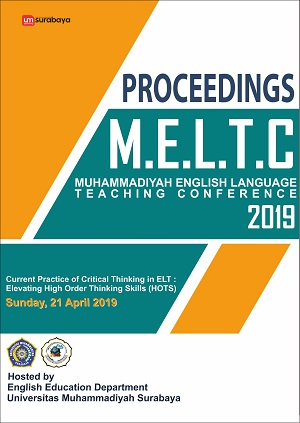English Teachers’ Investigation Of Windows Movie Maker As Technology In Teaching Speaking
Abstrak
Because of the widespread use of computers, most professions have been influenced by them in one way or another (Gough-Jones, 1995). Teachers need to be more creative in integrating technology into the classroom, especially in teaching speaking which is considered as the most challenging skill for students to learn. Thus, the aims of this study are to introduce Windows Movie Maker (WMM) as a technology in teaching speaking and to reveal the attitudes of ten English teachers towards its utilization. The implementation of WMM is illustrated through sample activities. Besides, to collect data regarding their attitudes, the participants were directly distributed a document consists of an introduction to this tool, tutorials on how to apply it, and sample of WMM slides. They were then asked to write their reflections on WMM application and kind of activities they could use in teaching speaking. The collected qualitative data was analyzed by means of content analysis. It was revealed that the participants mostly gave positive attitudes towards the use of WMM and they also shared their ideas about teaching activities incorporating this tool. In sum, the use of new technology in teaching speaking is likely to lead to a more effective ELT process.
Â
Keywords: Technology in ELT, Windows Movie Maker, Teaching Speaking.
Referensi
Albirini, A. A. (2006). Teacher’s attitudes toward information and communication technologies: The case of Syrian EFL teachers. Journal of Computers and Education, 47, 373-398. http://dx.doi.org/10.1016/j.compedu.2004.10.013
Brown, H. Douglas. (1994). Teaching by principles: an interactive approach to language pedagogy. NJ: Prentice Hall Regents. Cambridge University Press.
Cooke-Plagwitz, J. (2005). Adventures in teaching: Helping language teachers discover the joy of teaching with technology. The international Association for Language Learning Technologies Journal of Language Learning Technologies, 37(1), 35-40.
Dörnyei, Z. (2003). Attitudes, orientations, and motivations in language learning: Advances in theory, research, and applications. Language Learning 53(1), 3–32.
E. Taylor. (2007). Global learner: Students film making. Retrieved March 13, 2008, from http://www.princianteglobal.blogspot.com
Ferdig, R. E. (2007). Editorial: Examining social software in teacher. Journal of Technology & Teacher Education, 15(1), 5-10.
Fredrick, K. (2010). Learning Illustrated: Windows Live Movie Maker. 27 (2), pp.41-42. http://search.proquest.com.elibrary.jcu.edu.au/docview/759255726?pqorigsite=summon
Gupta, R. (2010). Technology in the English Language Classroom. Language in India, No 61-76.
J. Farrant & T. Farrant. (1980). Principles and Practice of Education (2nd Eds.). England: Longman Group UK Ltd.
J. Shaw. (2004). Introduction to Digital Media and Windows Media 9 series.
Krashen, S., & Terrel, T. (1995). The natural approach: Language acquisition in the classroom. Hertfordshire, Prentice Hall.
Miles, M. B. & Huberman, A. M. (1984). Qualitative Data Analysis: A Sourcebook of New Methods. California: SAGE Publication Inc.
O’Conner, P., & Gatton, W. (2003). Implementing multimedia in a university EFL program: A case study in CALL. In S. Fotos, & C.M. Browne (Eds.), New perspectives on call for second language classroom (pp. 199-224). Mahwah, NJ: Lawrence Erlbaum Associates
Oradee, Thalanyak. (2012). Developing Speaking Skills Using Three Communicative Activities (Discussion, Problem-Solving, and Role Playing). International Journal of Social Science and Humanity, Vol 2, No 6.
Raihan, M. A. & Lock, H. S. (2010). Technology integration for meaningful learning the constructivist view. Bangladesh Educational Journal, 11(1), 17-37
Sepehr, H., & Harris D. (1995). Teacher’s use of software for pupils with specific learning difficulties. Journal of Computer Assisted Learning, 11, 64-71. http://dx.doi.org/10.1111/j.1365-2729.1995.tb00118.x
Shyamlee, S., & Phil, M. (2012). Use of technology in English language teaching and learning: An analysis. Paper presented at the International Conference on Language, Medias and Culture IPEDR, IACSIT Press, Singapore.
Van Braak, J., Tondeur, J., & Valcke, M. (2004). Explaining different ttypes of computer use among primary school teachers. European Journal of Psychology of Education, 19(4), 407-422. http://dx.doi.org/10.1007/BF03173218
V. J. Gough-Jones, et al. (1995). Computer Studies for today pascal std 10 (2nd Eds.). Johannesburg: Lexicon Publishers.






